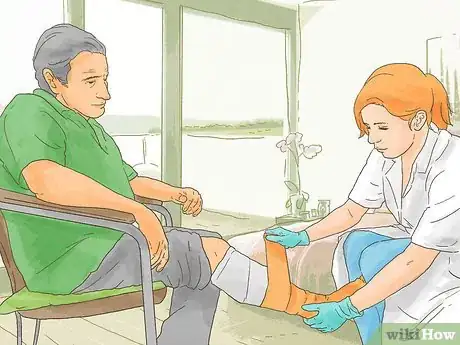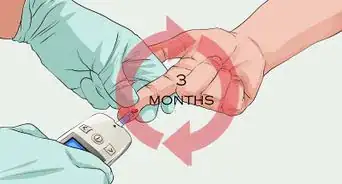This article was medically reviewed by Shari Forschen, NP, MA. Shari Forschen is a Registered Nurse at Sanford Health in North Dakota. Shari has worked in healthcare since 1996 and her expertise lies in acute care bedside nursing on a medical oncology floor. She received her degree from Medcenter one College of Nursing in 2003 and her Family Nurse Practitioner Masters from the University of North Dakota in 2014. Shari is a member of the American Nurses Association.
There are 14 references cited in this article, which can be found at the bottom of the page.
This article has been viewed 82,163 times.
A diabetes educator specializes in treating and educating diabetic patients at clinics or hospitals. You can become a diabetes educator by getting hands-on experience as a doctor, nurse, pharmacist, or other medical professional. Formalize your ability to provide diabetes patients with counseling and lifestyle management advice by obtaining official certification through the American Association of Diabetes Educators or the National Certification Board for Diabetes Educators.
Steps
Meeting Basic Requirements
-
1Choose the certification that is right for you. Decide if you want to become certified by the American Association of Diabetes Educators (AADE) or the National Certification Board for Diabetes Educators (NCBDE). Both organizations are reputable and have nearly identical requirements.
- The NCBDE certification is strictly focused on education. The AADE’s Board Certified-Advanced Diabetes Management certification, however, allows you to not only educate patients with diabetes, but also to participate in research and mentoring, adjust medications, and treat diabetes symptoms and complications.[1]
- For some people, the choice may come down to how much money and time you wish to spend on getting certified. The AADE certification is more expensive and might require a longer time investment than NCBDE certification.[2]
- You do not need to obtain both types of certification, but it might improve your career opportunities.
-
2Obtain relevant work experience. Relevant jobs include pharmacist, occupational or physical therapist, Dietitian, nurse, or other medical professional who provides diabetes self-management education (DSME) as part of their routine duties. You might also qualify if you have an advanced degree in a health-related field or concentration.
- DSME is defined as any activity by a healthcare professional that helps patients with diabetes understand and manage their condition.
- For the NCBDE certification, you need at least two years’ experience in your field and at least 1,000 hours of (DSME) experience. You must have worked at least 40% of these hours (400 hours) within in the last year.
- Certification with the AADE requires 500 practice hours over the course of the last four years.[3]
- NCBDE certification allows volunteer experience with a medical agency or health clinic to count toward your hourly total.[4]
- If you don’t work in the field but still want to obtain NCBDE certification, you must provide an official transcript of your advanced degree coursework and a copy of your academic degree. The rest of your requirements are identical to a traditional applicant.
Advertisement -
3Meet your continuing education requirements. While AADE certification has no continuing education requirement, the NCBDE certification does. In addition to relevant work experience, you’ll need at least 15 clock hours (not credit hours) of continuing education within the two years prior to submitting your application. These courses must be provided by an organization or institution approved by the NCBDE.
- Unlike credit hours, clock hours are counted in a simple, linear way. For instance, attending a class for two hours will earn you two clock hours.
- The American Medical Association, the American Diabetes Association, the American Association of Diabetes Educators, and similar organizations offer continuing education opportunities for diabetes educators.
- A full list of continuing education providers is available online at https://www.cbdce.org/documents/20123/66178/CEHandbookCurrent.pdf/82de0066-76f3-d4ff-485f-ca670f6f83bd.
- Continuing education cannot involve volunteering, original research, poster sessions or exhibits, writing an article or book, or academic courses.
- Acceptable continuing education activities include approved online programs, conferences, workshops, seminars, and independent study courses.
Moving Forward
-
1Complete the application. The easiest way to apply for NCBDE certification is online. You will be redirected to the web page of Psi/Amp, the company that administers the NCBDE certification test. The AADE application is also online.
- If you prefer a paper NCBDE application, you can print one out online. The document includes the handbook — a useful document that provides information about the exam — and the application, located at the end of the document. Mail your completed application to AMP, CDE Examination Application, 18000 W. 105th St., Olathe, KS 66061-7543.
- If you’re following the Unique Pathway application process for NCBDE certification (i.e, you are applying without work experience but with an advanced medical degree), fill out the application online.
- After submitting your NCBDE application, you should get an email notification letting you know that your application was received almost immediately. If submitting the paper application, you should get a written notification that your application was received within four weeks. Call Psi/Amp at (913) 895-4600 if your application has not been acknowledged within four weeks.
-
2Talk to your supervisor.[5] For both the certification programs, you don’t need to submit a formal list of your practical DSME hours, but you might be randomly selected for an experience audit. In that case, your supervisor will have to provide written verification that you have, in fact, obtained the necessary experience.
- Share your desire to earn NCBDE certification with your supervisor. That way, they will understand if you later ask for written verification of your work experience.
- Depending on your particular profession within the medical industry, your supervisor might be the head nurse, a doctor, or another medical professional.
-
3Pay the fee.[6] Your initial certification fee for the NCBDE test is $350. This fee covers the costs of processing your application and administering your exam. Your fee must be paid when you submit your application.
- The fee for the AADE test is much steeper. You’ll need to pay $600 if you’re an AADE member, or $900 if you’re not a member.
- An additional fee of $150 will be charged if you are testing for the AADE exam at a site outside the U.S.
-
4Choose a test center location.[7] Once your application has been processed and approved, you’ll receive information about how to select a test center location and time. In the case of either exam, if you don’t think you can be available for an in-person test, inquire about getting an online proctored exam. This will allow you to take the test online from another location.
Getting Certified
-
1Prepare for the test. There are several resources available to help you prepare for both certification exams. The NCBDE certification exam handbook has an appendix with an extensive list of resources. The AADE handbook also offers a list of useful resources in its appendix.[8]
- Appendix 3 in the NCBDE handbook offers a content outline. The content outline describes broadly what the diabetes education test will cover. Examine this content outline closely. Seek assistance from a mentor or consult diabetes education literature to answer questions you might have about the material.
- Appendix 5 in the NCBDE handbook offers a list of suggested references. Look over these references, taking notes as necessary, to sharpen your knowledge of specific content areas. Focus on areas that you are less familiar with in order to remedy any gaps in your understanding.
- For a $55 fee, you can take a practice NCBDE examination through Psi/Amp.[9]
- A practice AADE test is available online for $95.[10] A test tutorial to help you familiarize yourself with the computerized testing system is also available online.[11]
-
2Take the test. Visit the test center at the time and date you selected. Arrive early so that you have plenty of time to find a seat and settle in. The NCBDE test consists of 200 multiple-choice questions. You’ll have four hours to complete the exam. The AADE test consists of 175 multiple-choice questions administered over three-and-a-half hours.[12]
- Bring at least two types of valid, government-issued photo ID. You might bring a passport, driver’s license, military identification card, or state identification card with photo.
- You should also bring a printout confirming your test site, date, and other relevant information.
- Do not bring your phone, hat, electronics, or other personal items into the test center with you.
-
3Review your scores. The AADE exam results are mailed six to eight weeks after taking the exam. NCBDE scores are reported in two ways: raw scores and scaled scores.
- The NCBDE exam’s raw scores will give you your score as a percentage of the total number of questions you got correct out of 200. For instance, you might get a raw score of 150/200. Scaled scores are reported as a percentage of correct questions on a scale of 0 to 99. You must score at least a 70 on this scale in order to pass the exam. Using the above example — 150/200 — you would earn a 75, giving you a passing grade.
-
4Renew your certification. You must recertify your NCBDE and/or AADE credentials every five years.[13] Recertification for the NCBDE requires that you accrue at least another 1,000 hours of DSME and that you hold the same position in the same medical field that you held when you obtained certification originally.
- If you cannot meet the 1,000-hour practice requirement but wish to maintain your certification, you can substitute the practice requirement for 75 clock hours of continuing education.
- When your certification is close to expiration, the NCBDE, and/or AADE will send you a reminder notification along with directions outlining how to renew your certification.
- Renewal costs $250 for NCBDE certification and $500 for the AADE certification (or $800 if you are not an AADE member).
-
5Use your certification. With your new credentials, you’ll have a legitimate claim to expertise in the field of DSME. With your certification, you should be eligible for a pay raise. Broach the subject discretely with your employer.
- You might ask, for instance, what kind of financial benefits you’re eligible for as a certified diabetes educator.
- Many medical professionals find that they are more confident, respected, and financially secure as a result of earning their certification.[14]
Expert Q&A
-
QuestionIs a Physical Therapy assistant eligible to become a diabetes educator?
 Shari Forschen, NP, MAShari Forschen is a Registered Nurse at Sanford Health in North Dakota. Shari has worked in healthcare since 1996 and her expertise lies in acute care bedside nursing on a medical oncology floor. She received her degree from Medcenter one College of Nursing in 2003 and her Family Nurse Practitioner Masters from the University of North Dakota in 2014. Shari is a member of the American Nurses Association.
Shari Forschen, NP, MAShari Forschen is a Registered Nurse at Sanford Health in North Dakota. Shari has worked in healthcare since 1996 and her expertise lies in acute care bedside nursing on a medical oncology floor. She received her degree from Medcenter one College of Nursing in 2003 and her Family Nurse Practitioner Masters from the University of North Dakota in 2014. Shari is a member of the American Nurses Association.
Master's Degree, Nursing, University of North Dakota Physical therapy assistants can be trained for diabetes paraprofessional level 2 — there is a $175 online training course. Information can be obtained at: https://www.diabeteseducator.org/education-career/career-path-certificate/associate-level-2
Physical therapy assistants can be trained for diabetes paraprofessional level 2 — there is a $175 online training course. Information can be obtained at: https://www.diabeteseducator.org/education-career/career-path-certificate/associate-level-2
References
- ↑ https://www.diabeteseducator.org/education-career/certification/bc_adm
- ↑ https://www.diabeteseducator.org/education-career/certification/bc_adm/resources
- ↑ http://castleworldwide.com/aade/AppSystem/6/Public/Resource/AADE_Candidate_Handbook.pdf
- ↑ http://www.ncbde.org/assets/1/7/NewsRelease2014InitialCertChanges0713_Final.pdf
- ↑ http://www.ncbde.org/certification_info/certification-faqs/#126
- ↑ https://www.cbdce.org/documents/20123/66178/CBDCE-exam-handbook_Current.pdf/8e2fda09-9289-947c-7587-712a4e74f10a?t=1588269156519
- ↑ http://castleworldwide.com/aade/AppSystem/6/Public/Resource/AADE_Candidate_Handbook.pdf
- ↑ http://castleworldwide.com/aade/AppSystem/6/Public/Resource/AADE_Candidate_Handbook.pdf
- ↑ https://store.lxr.com/dept.aspx?id=71
- ↑ https://www.castleworldwide.com/cww/portal/test-info/12180
- ↑ http://www.castleworldwide.com/cww/take-a-sample-test/.
- ↑ http://castleworldwide.com/aade/AppSystem/6/Public/Resource/AADE_Candidate_Handbook.pdf
- ↑ https://castleworldwide.com/aade/AppSystem/6/Public/Resource/AADE_Candidate_Handbook.pdf
- ↑ http://www.ncbde.org/certification_info/why-am-i-a-cde/
About This Article
To become a diabetes educator, start by getting some experience providing diabetes self-management education, which you can do as a dietitian, pharmacist, or nurse. Additionally, consider completing an advanced degree in a health-related field or concentration. Then, research the requirements for certification from either the American Association of Diabetes Educators or the National Certification Board for Diabetes Educators. When you feel you meet the requirements, complete an application, pay the fee, and get ready to take the test. For information from our Medical reviewer on how to meet continuing education requirements to become a diabetes educator, read on!








































































